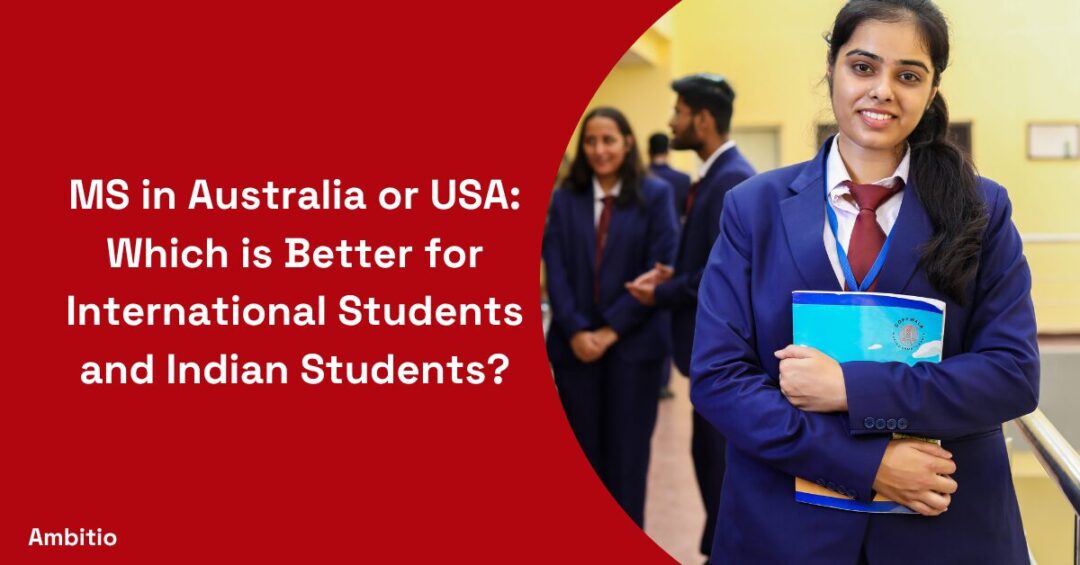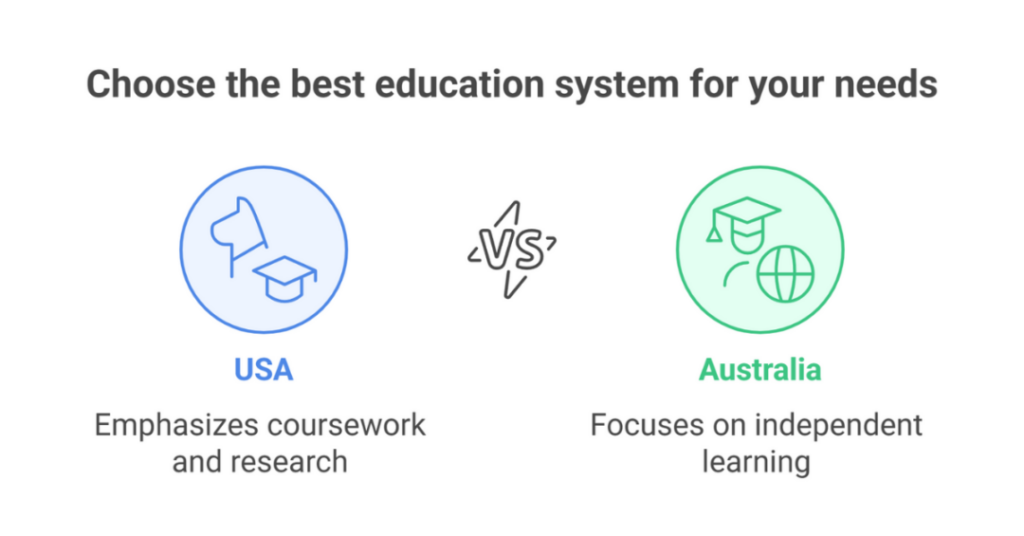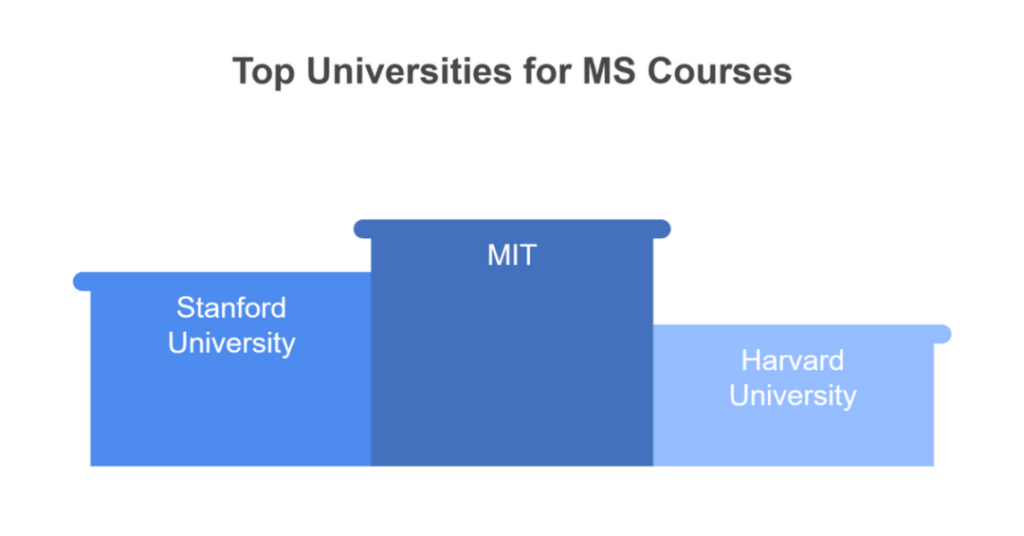18 June 2025
6 minutes read
MS in Australia or USA: Which is Better for International Students and Indian Students?

Key Takeaways
- MS in Australia or USA offers top-tier education; Australia allows easier entry and smoother post-study work options.
- MS in Australia or USA varies in cost; Australia is often more affordable with simpler visa pathways.
- MS in Australia or USA opens global careers; the USA leads in research, while Australia offers better work-life balance.
Choice between an MS in Australia or the USA to study abroad could feel like making a choice between two blockbuster movies.
Both countries are among the best places in the world to study abroad for international students and offer world-class education, multicultural community, and numerous research opportunities.
For Indian students interested in pursuing a master’s overseas, the option includes several factors—ranging from charges and eligibility criteria to career opportunities and living expenses.
While American universities are famous for high-stakes research and big alumni networks, Australian universities offer a relatively relaxed education system with an emphasis on work-life equilibrium.
The question really is: which of the two works best for your dreams, pocket, and studies? This article will help you make a very informed choice by comparing the two in every way that matters.
US vs Australia: What Does the Education System Look Like There?
Fun Fact: The USA has over 4,000 universities and colleges, while Australia has approximately 43 universities.

But it’s numbers that are misleading—both countries offer quality in education.
- USA: Semester system (Fall and Spring); emphasizes coursework, projects, and research.
- Australia: Semester or trimester system according to university; more independent study.
- USA: Offers Optional Practical Training (OPT) for 3 years for programs in STEM.
- Australia: Allows work up to 40 hours a fortnight during semesters and full-time during holidays.
- USA: More competitive, requires standardized test scores.
- Australia: Slightly more flexible with tests and admissions.
| Feature | USA | Australia |
|---|---|---|
| Academic Structure | Semester-based | Trimester/Semester-based |
| Focus | Coursework + Research | Research + Independent Learning |
| Work Opportunities | OPT (up to 3 years) | 40 hrs/fortnight (during study) |
| Entry Competitiveness | High (GRE/SAT/GMAT required) | Moderate (some tests optional) |
| Number of Institutions | ~4,000 | ~43 |
Study in USA vs Australia: What are the Admission Requirements for International Students?
Fun Fact: The University of Melbourne doesn’t always require GRE scores for MS courses—contrary to most American universities.
- Academic Transcripts: Both countries require undergraduate degree transcripts.
- Standardized Tests: USA typically requests GRE/GMAT; Australia may not.
- English Proficiency: IELTS or TOEFL scores in both.
- Documents: Statement of Purpose (SOP), Letters of Recommendation (LORs), resume.
- Work Experience: Preferred for some courses, especially MBA or management-oriented MS.

| Requirement | USA | Australia |
| Academic Record | Minimum GPA of 3.0 (varies by university) | Equivalent to Australian Bachelor’s |
| GRE/GMAT | Often required (especially STEM/MBA) | Rarely required (depends on course) |
| IELTS/TOEFL | Required (IELTS 6.5+, TOEFL 80+) | Required (IELTS 6.5+, TOEFL 79+) |
| SOP & LORs | Mandatory | Mandatory |
| Resume | Preferred | Preferred |
| Work Experience | Optional, preferred for certain courses | Optional, preferred for certain courses |
Eligibility Criteria for MS in Australia vs USA
Fun Fact: Some universities in Australia like the University of Technology Sydney accept students with three-year bachelor’s degrees, unlike many in the USA.
- Bachelor’s Degree: In the US, a four-year degree is usually the case; Australia accepts three-year degrees.
- English Proficiency: Both accept IELTS and TOEFL.
- Entrance Exams: GRE/GMAT are more common in US admissions.
- Academic Record: GPA is crucial; some US universities require 3.0+, Australian universities grade differently.
- Additional Docs: SOP, LORs, resume are required in both countries.
| Criteria | USA | Australia |
| Bachelor’s Requirement | 4-year degree | 3 or 4-year degree |
| IELTS/TOEFL | Required | Required |
| Entrance Tests | GRE/GMAT needed (varies by university) | Usually not required |
| SOP & LORs | Required | Required |
| GPA/Percentage | 3.0+ GPA or equivalent | Varies depending on university |
Cost of Studying: Tuition Fees and Scholarship Eligibility to Study in the US vs Australia
Fun Fact: Average tuition fees for an MS in Australia is about AUD 30,000 – AUD 45,000, and in the USA, about USD 25,000 – USD 60,000.
- Tuition Costs: Higher in the US; slightly lower in Australia.
- Living Expenses: Australia is expensive in the cities, Sydney; USA is state-specific.
- Scholarships: Both countries offer scholarships; more merit-based in the USA.
- Assistantships: Teaching/Research Assistantships are offered by US universities.
- Government Grants: Both nations offer them for international students.
| Cost Elements | USA (in USD) | Australia (in AUD) |
| Tuition Fees | $25,000 – $60,000/year | AUD 30,000 – AUD 45,000/year |
| Cost of Living | $10,000 – $20,000/year | AUD 20,000 – AUD 27,000/year |
| Scholarships | Yes (Merit-based) | Yes (Merit-based & Need-based) |
| Assistantships | Yes (TA/RA roles) | Rare |
| Government Grants | Fulbright, others | Destination Australia, others |
US or Australia: Quality of Education and Cost of Living
Fun Fact: Several Australian and American universities consistently make it to the top 100 in QS Rankings every year.
- University Rankings: Both countries boast top universities.
- Teaching Methods: US leans toward interactive, project-based learning; Australia prefers academic independence.
- Research Output: USA leads in volume and diversity.
- Living Costs: Sydney and Melbourne are costly; so are cities like New York and San Francisco.
- Student Support: Both countries have excellent support systems.
| Feature | USA | Australia |
| Top 100 Universities | Harvard, MIT, Stanford, etc. | University of Sydney, Melbourne |
| Living Costs | High (varies by region) | High (especially in metro cities) |
| Quality of Education | High | High |
| Teaching Style | Collaborative + Practical | Research + Academic |
| International Student Support | Excellent | Excellent |
Student Visa Application for International Students in USA vs Australia
Fun Fact: Australia allows international students to apply for a Temporary Graduate visa after graduation—making it easier to stay and work.
- Visa Types: F-1 (USA), Subclass 500 (Australia)
- Work Limitations: 20 hrs/week (both countries)
- Post-study Job Opportunities: US offers OPT; Australia offers post-study work visa.
- Financial Proof: Required for both.
- Processing Time: Australia generally quicker.
| Element | USA (F-1 Visa) | Australia (Subclass 500) |
| Work Hours | 20 hrs/week during semester | 20 hrs/week during semester |
| Post-Study Work | OPT (1-3 years) | Temporary Graduate Visa (2-4 years) |
| Visa Processing Time | 2 weeks to 3 months | 4 to 6 weeks |
| Financial Proof | Required | Required |
| Language Requirement | Yes (TOEFL/IELTS) | Yes (TOEFL/IELTS) |
Top Universities Which Offer Popular Courses for Students in US and Australia
Fun Fact: The University of Melbourne is among the top-ranked Australian universities globally, just like MIT and Stanford in the US.
Let’s compare some top universities that offer a wide range of MS courses:
Top 5 Universities in USA:
| University | QS Ranking | Fees (USD/year) | Popular MS Courses |
| MIT | 1 | $53,790 | Computer Science, Mechanical, AI |
| Stanford University | 5 | $55,473 | Data Science, Electrical Engg, Management |
| Harvard University | 4 | $51,904 | Economics, Public Policy, Bioinformatics |
| University of California, Berkeley | 10 | $44,000 | Cybersecurity, Chemical Engg, Civil Engg |
| Carnegie Mellon University | 28 | $47,300 | Robotics, Software Engg, Machine Learning |
Top 5 Universities in Australia:
| University | QS Ranking | Tuition Fees (AUD/year) | Popular MS Courses |
| University of Melbourne | 14 | AUD 45,000 | Data Science, Biomedical, Engineering |
| University of Sydney | 19 | AUD 44,000 | Law, Health Science, IT |
| Australian National University | 34 | AUD 43,000 | Physics, Policy, Computing |
| University of Queensland | 43 | AUD 41,000 | Agriculture, Nanotech, Marine Science |
| University of Technology-Sydney | 90 | AUD 39,000 | Business Analytics, Mechatronics, Telecom |
USA or Australia: Where Do More Number of International Students Study?
Fun Fact: The USA hosts over a million international students every year, while Australia hosts around 500,000—still huge considering the population difference.
- Volume of Students: USA leads in numbers.
- Diversity: Both countries are melting pots of cultures.
- Ease of Immigration: Australia is more immigration-friendly.
- Post-Study Options: More flexible in Australia.
- Preferred Fields: Tech and research in US, health and environment in Australia.
| Metric | USA | Australia |
| International Students/Year | 1,000,000+ | 500,000+ |
| % of Total Student Population | ~5% | ~25% |
| Immigration Ease | Moderate | Easier |
| Diversity Index | High | High |
| Fields of Study | STEM, Business, Research | Health, Environment, Business |
Conclusion
MS in Australia or USA—there is no one-size-fits-all winner—only what’s best for you. USA provides unmatched research opportunities, world-ranked universities, and organized academic programs.
It’s the best choice for those looking for intensive research work, varied employment opportunities, and a robust academic reputation.
However, Australia excels with its well-balanced lifestyle, comparatively lenient visa policies, and recognition of three-year bachelor’s degrees—particularly convenient for Indian students.
If cost of studying and a relaxed academic pace matter, Australian universities make a compelling case. But if you’re aiming for top-tier American universities and dream of working in Silicon Valley or Wall Street, the US education system will be your best friend.
Both countries offer high-quality education, support systems for international students, and degrees that hold global recognition.
Whatever option you decide, make sure to consider things such as eligibility criteria, visa regulations, quality of education, career opportunities, and living expenses. And remember: no matter where you might end up going, your willpower will shape your future more than any ranking ever could.
Study in Australia with Ambitio, your trusted study abroad partner!
FAQs
What makes MS in Australia or USA attractive to international students?
MS in Australia or USA offers globally ranked universities, cultural diversity, and excellent research and job opportunities.
Is MS in Australia or USA more affordable for Indian students?
MS in Australia or USA is often more budget-friendly in Australia due to lower tuition fees and cost of living.
Which country provides better post-study job options after MS in Australia or USA?
MS in Australia or USA leads to good employment, but Australia has easier work visas, while the USA offers OPT extensions for STEM.
Are scholarships available for MS in Australia or USA?
MS in Australia or USA provides a variety of scholarships, with the USA offering more assistantships and Australia focusing on merit and need-based aid.
Is the visa process simpler for MS in Australia or USA?
MS in Australia or USA has structured visa processes, but Australia is known for faster approvals and better post-study stay options.
Which degree is more globally recognized—MS in Australia or USA?
MS in Australia or USA degrees are highly respected, with the USA having a slight edge in global recognition for STEM fields.
Can a three-year Indian degree qualify for MS in Australia or USA?
MS in Australia or USA eligibility differs; Australia usually accepts three-year degrees, while the USA prefers four-year programs.

You can study at top universities worldwide!
Get expert tips and tricks to get into top universities with a free expert session.
Book Your Free 30-Minute Session Now! Book a call now




























